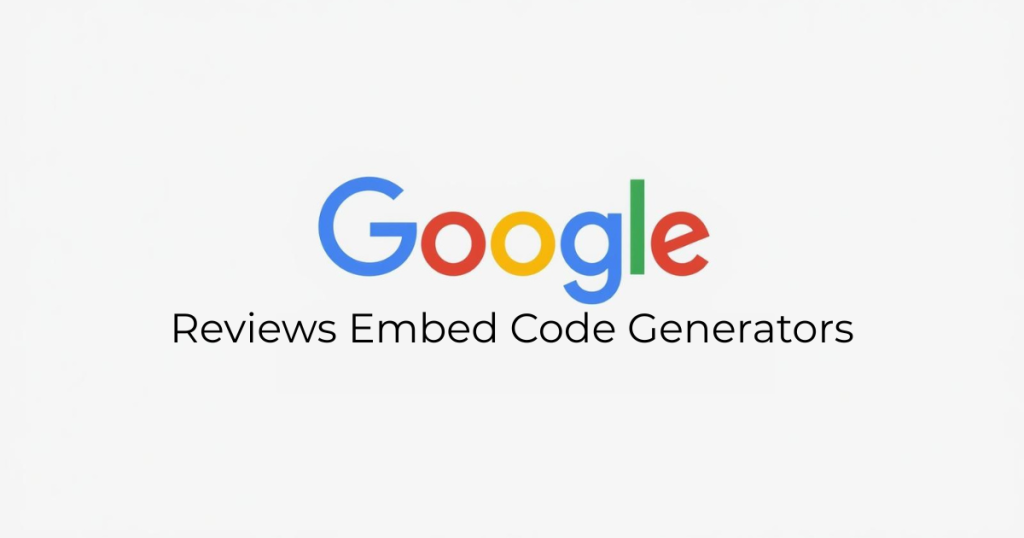Embedding real customer feedback on your website is one of the fastest ways to build trust and reduce buying friction. Instead of copy-pasting screenshots, a Google review embed code generator lets you pull fresh reviews, style them, and paste a lightweight snippet anywhere, no custom dev required.
These tools generate responsive, on-brand review sections that auto-refresh and protect page speed. Perfect for marketers, web designers, and multi-location brands that want credible social proof near key CTAs.
List of Top 5 Google Review Embed Code Generators:
1) Taggbox

Best for: Brands that want end-to-end execution, curation, design control, analytics, and multi-location management.
Overview: Taggbox connects to your Google Business Profile, lets you moderate/pin reviews, and publishes responsive layouts (cards, lists, carousels) with custom CSS and dark mode options. You can run separate feeds for product, pricing, and location pages, then track impressions, clicks, and post-view actions.
Why it stands out:
- Solid moderation (approve/hide, keyword filters, pin “hero” quotes).
- Clean presets + custom CSS for exact brand match.
- Analytics that help prove lift near CTAs.
- Works across WordPress, Shopify, Webflow, Wix, and custom stacks.
Perfect for: Teams that want a dependable google review widget they can deploy across many pages, once styled, easily reused site-wide.
2) Elfsight

Best for: Small teams who need beautiful displays with minimal configuration.
Overview: Elfsight’s Google Reviews widget is known for polished presets and a fast, no-code setup. Choose a layout (grid, list, slider), toggle reviewer name/date, and paste the snippet.
Why it stands out:
- Designer-friendly themes that look great out of the box.
- Quick visual editor; minimal learning curve.
- Responsive, mobile-first embeds that play nicely with most CMSs.
Perfect for: Solo marketers and SMBs who want stylish social proof without fiddling.
3) Tagembed

Best for: Agencies and site builders managing multiple client sites (strong WordPress/Shopify coverage).
Overview: Tagembed provides Google review widgets with filters, layout presets, and simple moderation. The WordPress plugin and Shopify app make installs quick for non-technical editors.
Why it stands out:
- Speed to publish across CMSs.
- Practical filtering (by rating/keywords) to keep blocks on-brand.
- Clean dashboards to manage many properties.
Perfect for: Web pros who value repeatable setups and easy hand-offs.
4) EmbedSocial

Best for: Teams that plan to expand beyond Google to other review sources.
Overview: EmbedReviews supports Google now and lets you layer in Facebook/Yelp later, with a consistent workflow: connect, curate, style, embed.
Why it stands out:
- Multi-source strategy under one roof.
- Clear moderation and gallery options.
- Works well for brands consolidating tools across regions.
Perfect for: Growth teams standardizing review ops across markets.
5) SociableKIT

Best for: Non-technical teams that need guaranteed compatibility with common site builders.
Overview: SociableKIT ships step-by-step guides for Wix, Weebly, Google Sites, WordPress, and more, handy when your stack changes or varies by location.
Why it stands out:
- Builder-specific instructions lower setup friction.
- Sensible defaults and straightforward styling.
- Good option for franchises and schools with mixed CMSs.
Perfect for: Organizations that can’t rely on custom code and want a predictable, copy-paste path.
Why use an embed generator?
- Real trust, right where it counts: Place fresh reviews beside pricing, product CTAs, and booking forms to reduce hesitation, the core benefits of google reviews in action.
- Fast, no code: Copy a snippet, style once, reuse everywhere.
- Always current: Auto-refresh pulls in new reviews; no more stale screenshots.
- Performance-safe: Most tools offer lazy loading and CDN-served assets to protect Core Web Vitals.
- Scales to many pages/locations: Standardize layouts, then localize sources per store or clinic.
Where to place them (quick wins)
- Pricing and checkout: A compact row next to your primary CTA.
- Product/service pages: 3–6 short, specific quotes addressing fit, delivery, or support.
- Location pages: Per-store feeds for local relevance.
- Onboarding/thank-you pages: Reinforce “you chose well” moments.
- In-store screens/events: Rotating testimonials for real-world influence.
Setup playbook (10 minutes)
- Pick a page and goal (reduce cart abandonment, validate pricing, increase bookings).
- Curate recent, specific quotes; pin one “hero” review.
- Embed and style; keep above-the-fold blocks to 3–4 items and lazy-load the rest.
- Track GA4 events: impressions, review clicks, and downstream CTAs.
- Refresh monthly; rotate themes (delivery → quality → support).
Pro tips
- Accessibility: Ensure readable contrast, keyboard navigation, and alt text for any reviewer images.
- Governance: Avoid editing meanings; attribute clearly (name/initial + date).
- Performance: Compress avatars, reserve space to prevent layout shift, defer non-critical scripts.
- Multi-location: Standard theme, per-location sources; assign an owner for monthly curation.
Planning add-on (optional)
For quarterly goals, pair your display tool with a lightweight rating calculator to set realistic targets for new, high-star reviews, then pace requests weekly with email/SMS or in-person QR prompts.
Conclusion
Pick one generator, place a lean block near high-friction CTAs, and measure the lift. As you scale, add moderation, analytics, and per-location feeds so every visitor sees relevant, recent proof. That steady, honest approach is how you boost google reviews over time, because authentic feedback, shown at the right moment, drives clicks, conversions, and long-term trust.

